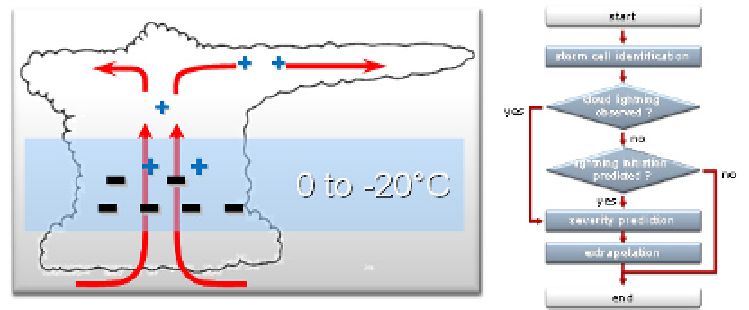Geoscience Reference
In-Depth Information
6.6 SWIRLS and its variants - Hong Kong, China
In Hong Kong, lightning strikes and damaging squalls are major threats accompanying
thunderstorms. In support of the Thunderstorm Warning operations, SWIRLS (
S
hort-range
W
arning of
I
ntense
R
ainstorms in
L
ocalized
S
ystems) was developed to track and predict
severe weather including rainstorms, cloud-to-ground (CG) lightning, damaging
thunderstorm squalls and hail for the general public. The warning decision and message
preparation are made by the Observatory's duty forecaster. Once issued, the warning
message are disseminated automatically through various channels including radio and
television broadcast automatic telephone enquiry system, Internet web page, as well as
mobile apps for smart phones and social networking platforms such as Twitter.
An innovation is the DELITE (
D
etection of cloud
E
lectrification and
L
ightning based on
I
sothermal
T
hunderstorm
E
choes) algorithm for lightning warning. It selects radar and
other parameters most relevant to the microphysical processes leading up to the
electrification of a cumulus cloud (Fig. 10). This includes radar reflectivity at constant
temperature levels (0C, -10C, and -20C), the thermal profile of the troposphere (from
either numerical weather model analysis or the latest available radiosonde data), the echo
top height and the vertically integrated liquid (VIL). CG lightning initiation is expected if
prescribed thresholds are exceeded.
The above severe weather analyses are performed on a cell basis and the threat areas are
identified as elliptical cells in the corresponding interest fields with values greater than or
equal to prescribed thresholds. For example, the detailed cell identification technique follows
the GTrack algorithm of SWIRLS. For lightning and downburst, the interest fields are 3-km
CAPPI and 0-5 km VIL respectively. The thresholds are 25 dBZ and 5 mm respectively.
MOVA
(M
ulti-scale
O
ptical flow by
V
ariational
A
nalysis) is a gridded echo-motion field that
is derived from consecutive radar reflectivity fields by solving an optical-flow equation with a
smoothness constraint. To capture multi-scale echo motions, the optical-flow equation is
solved iteratively for a cascade of grids from coarse to fine resolutions (about 512 to 3 km).
Fig. 10. (a) Conceptual model of CG lightning. The main source of electric charges is assumed
to be located in the mixed-phase layer between 0 and -20C. Prior to electrification, the updraft
is expected to separate the charge carriers vertically. Negative charge carriers (i.e. graupel) are
expected to reside mainly in the mixed-phase layer. The updraft pumps super-cooled rain
water into this layer and wet the carriers. (b) Flow chart of the logic of the algorithm.


